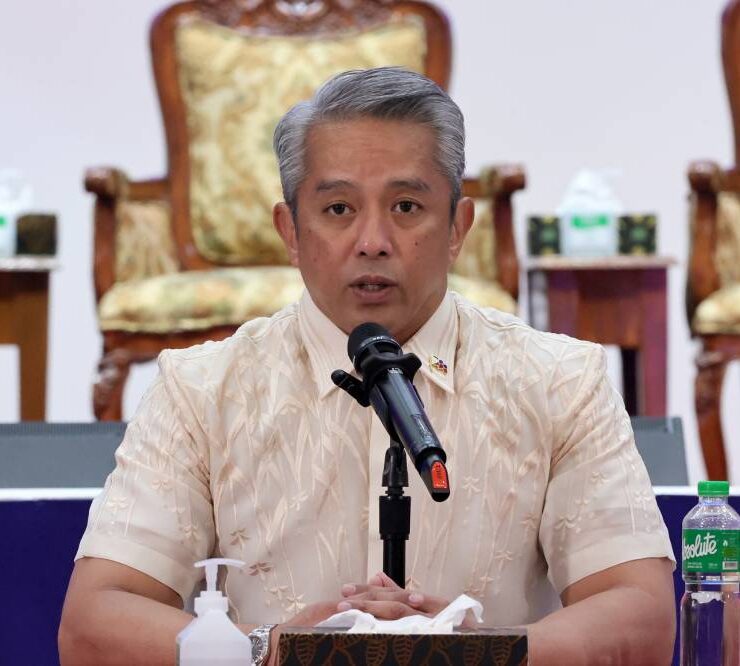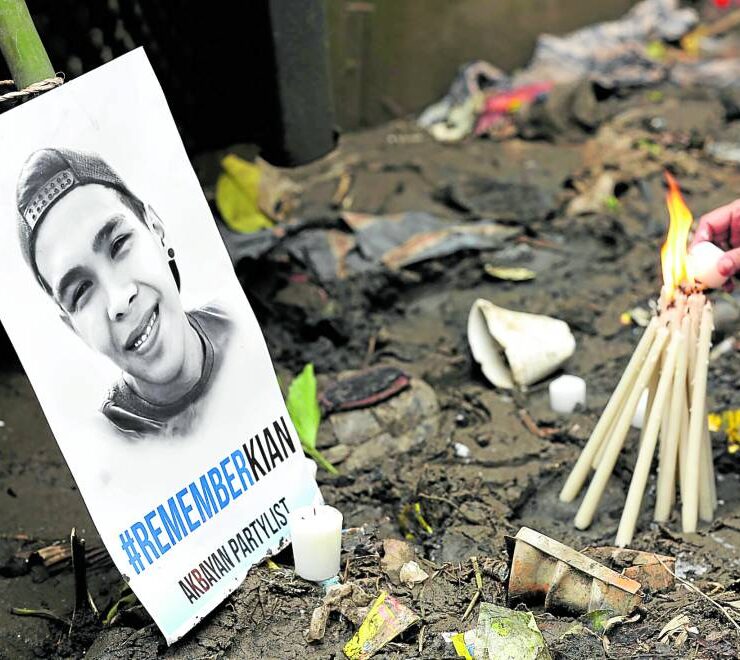‘So, go na tayo, ha!’: Remembering Floy Quintos

Those were the last words veteran playwright-director Floy Quintos said to the actors and members of the creative team after handing in the final draft of the script for what would become his swan song, “Grace.”
The true story of Sister Teresing Castillo and the reported apparitions and miracles that were headline news in 1948 was among more than a dozen plays categorized as historical fiction that Quintos wrote. It would be the final collaboration he would have with director-choreographer Dexter Martinez Santos, who directed almost all of Quintos’ plays for Dulaang Unibersidad ng Pilipinas (DUP).
It has been an 11-year-long collaboration between him and Quintos, as Santos wrote in his eulogy. If Quintos’ career in theater would be divided into two, the first phase started during his high school years at the University of the Philippines (UP) Integrated School up to his college years at the UP Diliman.
“I’ve always been enamored with historical subject matter, but in high school, I wrote a one-act play titled ‘C.R.’ about a troubled child who kept on hiding in the comfort room,” Quintos said, giggling, in an online interview with playwright and Ateneo de Manila University professor Glenn Sevilla Mas that has been made available on YouTube.
He took up BA Mass Communication majoring in journalism with a minor in theater. This was when he learned from the masters in the fields. He told Mas how he learned good writing from his professor, Louie Beltran, and theater from future National Artists for Theater Tony Mabesa and Amelia Lapeña-Bonifacio.
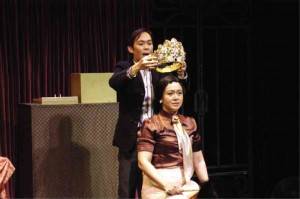
First play
It was Mabesa who asked him to write plays. “I was very much in love with theater. When I enrolled in the summer workshop of DUP, we had lectures from the likes of Anton Juan and (Zeneida) Bibot Amador. Many thought there was a great divide between theater practitioners in Filipino and English, but Bibot was among our lecturers. To use a term used by [theater critic and editor] Gibbs Cadiz, we were in the presence of this constellation of great talents.”
When Mabesa was doing productions at the Metropolitan Theater, he asked Quintos to be part of the marketing team, writing press releases and coordinating with the media. Later, he would be assigned as production manager. Both experiences he was very much thankful for.
“You learn to relate to all kinds of people in the theater, besides the actors, from marketing to technical. You learn in whatever field you’re going to. That’s why later on when I went corporate, I said the best managers are those I met in theater,” Quintos told Mas.
“I think theater people can run the nation if you let them. Their obsession for details, appearances in public, ‘Ay, bakit nandyan mga kable,’ why are these exposed, all these tiny little details that make for the illusion of perfection that theater offers. This needless obsession for details in the end would make the production beautiful.”
Mabesa asked him to write his first two-act play that was produced at the Met. Imitating how Mabesa spoke in his baritone voice, Quintos said, “’Masyado ka nang nagiging production, ’di ba may nasulat ka ng play? Why don’t you write one?’ And so Tony directed it, but I was also producer.”
Titled “Gironière: The Lord of Jalajala,” it was about a French traveler in the 18th century from Nantes, France, named Paul P. de la Gironière, who came to the Philippines and lived in the coastal town of Jalajala, in what is now Rizal Province, for 20 years. He wrote about his experiences in a book titled “Adventures in the Philippines.”“When I read it, I thought, napaka-theatrical nito. So I wrote the play, the script of which I thought was lost,” he told Mas. “That’s how I learned about budgeting, appeasing senior actors like Alex Cortez, Madeleine Nicolas,” Quintos said.
“Those were lessons in humility. After that I went into magazine journalism, television, events, concerts, films with Mario O’ Hara, Ishmael Bernal. I was young, I was, what, in my 30s, so for the next 15 years, I did those. Nilamon na ako ng sistema,” he said, laughing again.
He told Mas how journalism and doing things other than theater helped him in his craft, of being objective in seeing things, of being well-rounded. As National Artist for Literature Nick Joaquin wrote, “Eccentricity is such a temptation to the creative writer because he tends to be self-indulgent.” All these experiences became his materials when he wrote his landmark plays after reaching middle age.
Second act
“When I turned 48, I decided to go back, and being away from the theater gave me so much to say.”
Thus began the second phase of his career as playwright. There was no looking back. The first play he wrote was “Fluid,” in 2004, which was about the artists and the hypocrisy and opportunism in the art world.
“It has the distinction of being produced by UP, Ateneo and Dela Salle University–College of Saint Benilde.” Second was “Fake,” followed by “Laro,” “Shock Value,” then “Atang” and many others. The first few plays were directed by Alexander Cortez and Mabesa, with Santos as choreographer.
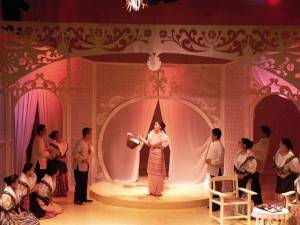
Thus also began what he called “The Dexter Martinez Santos years.” Santos started with DUP in 2005 but it was not until late 2012 when he directed a play written by Quintos, titled “Collection.” It was followed by “Ang Nawalang Kapatid,” “Ang Huling Lagda ni Apolinario Mabini,” “Angry Christ,” “The Kundiman Party” and “The Reconciliation Dinner.” Santos told Inquirer Lifestyle that the last time he and Quintos saw each other in the flesh was on April 7, about 10 days before Quintos celebrated his 63rd birthday.
“It was the second day of the script reading for ‘Grace,’” said Santos. But they communicated with each other almost every day. “We talked last Thursday (April 25) and messaged each other Friday evening. Iba-iba, mostly private but, yes, among them was about ‘Grace.’”
It would be the last time Santos would receive responses from his friend and mentor.
On Saturday morning, April 27, Quintos was rushed to the emergency room of a nearby hospital where he passed away. He was 63. It was a heart attack, the traitor that remains the top cause of deaths in the Philippines.

April, as how T.S. Elliot wrote in the first line of his 1922 poem “The Wasteland,” is the cruelest month. In a literal sense, there was the punishing hot weather in one of the busiest months in Philippine theater, or at least in Metro Manila. That weekend, it was a usual busy Saturday for theater lovers who were probably checking boxes on their “must-watch list,” what with the ongoing Asian tour of “Miss Saigon,” the restaging of “Rent,” the opening weekend of “Buruguduystunstugudunstuy: Ang Parokya Ni Edgar Musical,” the ongoing “One More Chance: The Musical,” “Ang Karera Ni Rosang Taba” and the limited run of the Filipino adaptation of “The Seagull” titled “Ibon Ng Lawa.”
There were also the ongoing rehearsals of “Bar Boys” and “Grace.” In the local theater village, all productions mentioned had actors and members of the creative team who were former students, workmates and/or friends of Quintos. The Quintosians (to use a term everyone has become familiar with) were all shocked, devastated and in denial at the news of Quintos’ sudden passing.
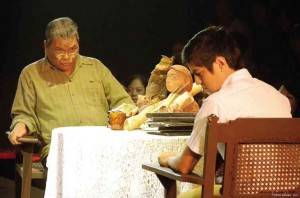
Everything for the play
“Who wouldn’t want to join a Quintosian play? A master playwright. A genius who can impeccably mix history, culture, and fiction and elevate it to iconic scenes. An actor’s playwright. Highly psychological characters, monologues that would test one’s range, speech that rolled trippingly on the tongue,” Santos wrote in his eulogy.
“He wrote with actors in his mind. Or sometimes, adjusted it to the actor’s temper and range. An audience’s playwright. His works were diverse—spanning time and genres—but the audience always went home enriched. His works will always touch one’s soul.
“Masarap katrabaho ang isang Floy Quintos. Walang pagpapanggap, walang yabang, truthful, sincere, maalaga. The audience always experienced his brilliance on stage. But beyond that was a man who would do everything for the show,” Santos wrote.
In presenting sociopolitical themes, Quintos’ works had always been in-your-face, brutally honest and brilliantly executed. While some would play it safe or try to hide in metaphors or totally serve purely entertaining productions, Quintos brought us “The Kundiman Party” as a reaction to the Duterte administration and “The Reconciliation Dinner” in the second Marcos presidency.

Santos said there have been plans or talks to do sequels or updated versions of these Quintosian masterpieces. But in Quintos’ interview with Mas, he spoke about devoting himself to something else—writing a play titled “The Prize.” “It is about Nick Joaquin and how the National Artist award was dangled in front of him by the Marcos administration in exchange for the freedom of this brilliant poet and journalist,” Quintos said, not naming the poet but actually referring to a martial law survivor, the great writer Pete Lacaba.
Other writers may attempt to do that, but it would never be like a Quintosian play. More than anything, it’s the bravery of Quintos’ works, the daring narratives, that Quintosian audiences would remember.
In “Atang,” Quintos wrote this dialogue for the character of National Artist for Theater and Music Atang dela Rama—a timeless reminder for all artists: “Isa pa ’yang tatandaan mo bilang alagad ng sining. Mas mahalaga ang naudyok mo ang iisang tao…kaysa sa libo-libong matutuwa lang at agad namang makakalimot (That’s one thing you need to remember as a stalwart of the arts. It’s more important to compel a single person to action than to entertain thousands who will immediately forget).”“Yes, go na tayo!” INQ


















